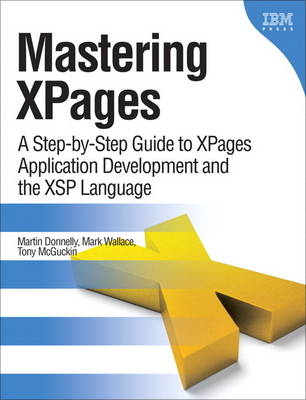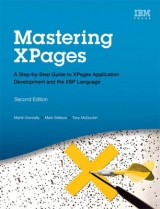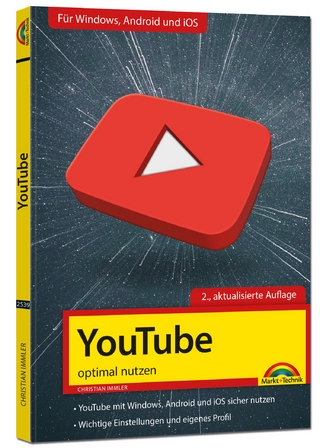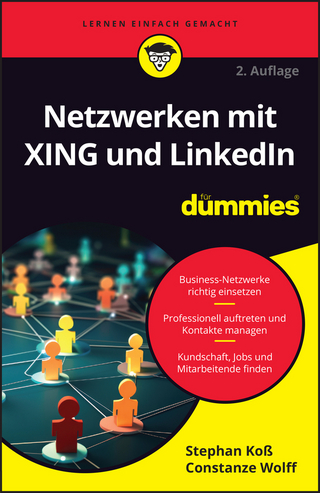
Mastering XPages
IBM Press (Verlag)
978-0-13-248631-6 (ISBN)
- Titel erscheint in neuer Auflage
- Artikel merken
Martin Donnelly, Mark Wallace, and Tony McGuckin have written the definitive programmer's guide to utilizing this breakthrough technology. Packed with tips, tricks, and best practices from IBM's own XPages developers, Mastering XPages brings together all the information developers need to become experts - whether you’re experienced with Notes/Domino development or not. The authors start from the very beginning, helping developers steadily build your expertise through practical code examples and clear, complete explanations. Readers will work through scores of real-world XPages examples, learning cutting-edge XPages and XSP language skills and gaining deep insight into the entire development process. Drawing on their own experience working directly with XPages users and customers, the authors illuminate both the technology and how it can be applied to solving real business problems.
Martin Donnelly previously led a software startup that developed and distributed small business accounting software. Donnelly holds a Commerce degree from University College Cork and an M.S. in Computer Science from Boston University.
Mark Wallace has worked at IBM for 15 years on many projects as a technical architect and application developer.
Tony McGuckin participates in the Lotus OneUI Web Application and iWidget Adoption Workgroup. He holds a bachelor's degree in Software Engineering from the University of Ulster.
The authors of this book have a number of things in common. All three hail from Ireland, work for the IBM Ireland software lab, and have made significant contributions to the development of XPages over the past number of years. Martin Donnelly is a software architect and tech lead for the XPages runtime team in IBM Ireland and has worked on all three XPages releases from Notes/Domino 8.5 through 8.5.2. Prior to this, Martin also worked on XFaces for Lotus Component Designer and on JSF tooling for Rational Application Developer. In the 1990s while living and working in Massachusetts, he was a lead developer on Domino Designer. Now once again based in Ireland, Martin lives in Cork with his wife Aileen, daughters Alison, Aisling, and Maeve, and retired greyhounds Evie and Chelsea. Outside of work, he confesses to playing soccer on a weekly basis and salmon angling during the summer when the opportunity presents itself. Mark Wallace is a software architect working in the IBM Ireland software lab. In the past, he worked on the XSP runtime, which was developed for Lotus Component Designer and subsequently evolved into the XPages runtime. He has a keen interest in programming models and improving developer productivity. Mark has worked in Lotus and IBM for more than 15 years on various products and is currently working on Sametime Unified Telephony. Mark lives in Dublin with his wife and two children and spends as much time as possible in the Ireland’s sunny south east enjoying fishing and kayaking with his family. Tony McGuckin is a senior software engineer in the IBM Ireland software lab. Having studied software engineering at the University of Ulster, he began his career with IBM in 2006 working in software product development on the component designer runtime before moving into the XPages core runtime team. When not directly contributing to the core runtime, Tony is busy with software research and development for the next generation of application development tooling, and also engaging directly with IBM customers as an XPages consultant. Tony enjoys spending time with his wife and daughter, and getting out into the great outdoors for hill walking and the occasional chance to do some hunting in the surrounding hillsides of his native County Derry.
Foreword by Philippe Riand xx
Preface xxiv
Part I: Getting Started with XPages 1
Chapter 1 An Introduction to XPages 3
XPages Fundamentals 3
Brand New Technology? 4
A Different Development Paradigm 5
The More Things Change, the More Things Stay the Same 7
New Horizons 7
Conclusion 8
Chapter 2 Getting Everything You Need 9
Downloads, Versions, and Locations 9
Installing Domino Designer 10
Installing Client Fix Packs 11
Client Configuration 11
Quick Tour of Domino Designer 12
Domino Designer Welcome Screen 13
Domino Designer Perspective 14
Creating a New Application 15
Creating an XPage 16
Previewing in the Notes Client 18
Previewing in a Web Browser 18
Adding a Control to an XPage 21
Conclusion 22
Chapter 3 Building Your First XPages Application 23
Laying the Foundations 24
Forms and Views 26
Building an XPages View 31
Completing the CRUD 36
Conclusion 42
Part II: XPages Development: First Principles 43
Chapter 4 Anatomy of an XPage 45
What Exactly Is an XPage? 46
Understanding XSP Tag Markup 47
Getting Started with XML 47
XPages XML Syntax 50
Simple Properties 52
Complex Properties 54
Complex Values 54
Computed Properties 55
Data Binding 59
XPages Tags 60
Data Sources 61
Domino Document 61
Domino View 62
Data Context 63
Controls 64
Editing Controls 64
Command Controls 70
Selection Controls 74
Display Controls 82
File-Handling Controls 84
Containers 87
Panel 87
Table 90
View 91
Data Table 94
Repeat 95
Include Page 99
Tabbed Panel 99
Section 100
XPage Resources 101
Script Library 101
Style Sheet 103
Resource Bundle 104
Dojo Module 105
Generic Head Resource 106
Metadata Resource 106
Converters 107
Validators 110
Simple Actions 118
Client-Side Scripting 125
HTML Tags 127
Conclusion 128
Chapter 5 XPages and JavaServer Faces 129
What Is JavaServer Faces? 130
JSF Primer 131
How Does XPages Extend JSF? 138
XML-Based Presentation Tier 141
Request Processing Lifecycle 142
User Interface Component Model 143
Standard User-Interface Components 148
Value Binding and Method Binding Expression Evaluation 152
XPages Default Variables 154
Conclusion 156
Chapter 6 Building XPages Business Logic 157
Adding Business Logic 157
Using the xp:eventHandler Tag 160
Simple Actions 167
Change Document Mode 168
Confirm Action 169
Create Response Document 170
Delete Document 171
Delete Selected Documents 172
Execute Client Script 173
Execute Script 173
Modify Field 174
Open Page 175
Publish Component Property 176
Publish View Column 177
Save Data Sources 179
Save Document 180
Set Component Mode 182
Set Value 183
Action Group 184
Using JavaScript with XPages 186
Server-Side JavaScript 186
Client JavaScript 206
Conclusion 211
Part III: Data Binding 213
Chapter 7 Working with Domino Documents 215
Domino Document Data Source 216
Creating and Editing Documents 219
Controlling URL Parameter Usage 220
Creating Response Documents 220
Executing Form Logic 224
Managing Concurrent Document Updates 227
Multiple Document Data Sources 228
Document Data Source Events 231
Common Data Source Properties 233
Miscellaneous Data Source Properties 234
Working with Domino Documents–Programmatically! 235
Simple Actions 235
JavaScript 236
Rich Documents 238
Conclusion 242
Chapter 8 Working with Domino Views 243
databaseName Property 245
View Data Source Filters 246
categoryFilter Property 246
search, searchMaxDocs Properties 249
parentId Property 251
ignoreRequestParams Property 252
keys, keysExactMatch Properties 253
Other View Content Modifiers 256
startKeys Property 256
expandLevel Property 257
A Page with Two Views 259
requestParamPrefix Property 260
When Is a View Not a View? 261
Go Fetch! Or Maybe Not... 262
loaded, scope Properties 263
postOpenView, queryOpenView Properties 263
Caching View Data 265
Sorting Columns 270
Conclusion 271
Chapter 9 Beyond the View Basics 273
Pick a View Control, Any View Control 273
The View Control: Up Close and Personal 276
Column Data Like You’ve Never Seen Before 277
Simple View Panel Make Over 279
Working with Categories 293
View Properties and View Panel Properties 301
Data Table 305
Building a Mini Embedded Profile View using a Data Table 311
Repeat Control 316
A Repeat Control Design Pattern 317
Nested Repeats 318
The Rich Get Richer 320
Some Fun with the Pager 321
Conclusion 324
Part IV: Programmability 325
Chapter 10 Custom Controls 327
Divide and Conquer 328
Getting Started with Custom Controls 329
Using Property Definitions 337
Property Tab 340
Validation Tab 343
Visible Tab 345
Property Definitions Summary 346
Using the compositeData Object 346
Send and You Shall Receive 352
Multiple Instances and Property Groups 355
Custom Control Design Patterns 357
Aggregate Container Pattern 357
Layout Container Pattern 358
Conclusion 365
Chapter 11 Advanced Scripting 367
Application Frameworks 367
AJAX and Partial Refresh 369
Partial Refresh: Out-of-the-Box Style! 369
Partial Refresh: Doing-It-My-Way Style! 376
Event Parameters 384
Dojo Integration 386
dojoTheme and dojoParseOnLoad Properties 387
dojoModule Resource 388
dojoType and dojoAttributes Properties 389
Integrating Dojo Widgets and Extending the Dojo Class Path 390
Working with Traditional Notes/Domino Building Blocks 401
Working with @Functions, @Commands, and Formula Language 402
Working with Agents, In-Memory Documents, and Profile Documents 405
Managed Beans 412
Conclusion 419
Chapter 12 XPages Extensibility 421
How to Create a New User Interface Control 422
Example Component 423
Let’s Get Started 424
Create the Initial Application 424
Add Package Explorer to the Domino Designer Perspective 424
Add a Java Source Code Folder 426
Building a Component 428
Create a UI Component Extension Class 428
Create Tag Specificaton (.xsp-config) for the UI Component Extension 431
Create a Renderer and Register It in the Application Configuration (faces-config.xml) 434
Quick Test Application to Verify Everything Is OK So Far 437
Working with Component Properties 438
Component Properties and Attributes 438
Adding a Property to a Component 439
State Holder: Saving State Between Requests 440
Specifying Simple Properties 440
Inheriting xsp-config Properties 441
Create the Initial xsp-config Definitions 446
Create base.xsp-config 446
Create an Interface to Match the Group Property Definition in base.xsp-config 450
Revisit the Component Properties in Domino Designer 452
Specifying Complex Properties 453
Complete the xsp-config for the UISpinner Component 464
Complete the UI Component Extension, UISpinner 473
Complete the Renderer UISpinnerRenderer 477
Create a Sample Application Using the UISpinner Component 483
Take Your New UI Component Extension for a Test Drive 483
Create a Backing Bean 483
Register the Backing Bean 486
Create the Final Test Application 486
Nice Look and Feel 491
Test to Ensure That It All Works! 491
Where to Go From Here 491
XPages Extensibility API Developers Guide 492
XPages Extension Library 492
IBM developerWorks 492
Conclusion 493
Chapter 13 XPages in the Notes Client 495
Think Inside the Box 496
Getting Started with XPages in the Notes Client 498
3, 2, 1...Lift Off 499
Bookmarks 501
Working Offline 503
One of These Things Is Not Like the Other 507
Other Subtle Differences 508
XPages: A Good Notes Citizen 511
Introducing enableModifiedFlag and disableModifiedFlag 513
Keeping Tabs on Your Client Apps 516
Notes Links Versus Domino Links 520
Some Debugging Tips 525
XPages and Composite Applications 528
Making a Component of an XPages Application 529
Is Anyone Out There? Creating a Component that Listens to Your XPages Component 531
Assembling a Composite Application: Aggregating the XPages Discussion Component and Notes Google Widget 533
Hey, This Is a Two-Way Street! A Component May Receive and Publish Events! 536
Further Adventures with Composite Applications 540
Part V: Application User Experience 541
Chapter 14 XPages Theming 543
It Used to Be Like That...But Not Anymore! 543
Styling with Style! 545
Setting the Style Property Manually 550
Understanding How the Style Property Is Used 551
Computing the Style Property 552
Styling with Class! 552
Getting Something for Nothing! 553
Understanding How the styleClass Property Is Used 559
Computing the styleClass Property 561
Working with Extended styleClass and style Properties 563
Theming on Steroids! 567
What Is a Theme? 567
What Can You Do with a Theme? 568
Understanding Theme Architecture and Inheritance 569
Working with a Theme 576
Theme Resources 587
Resource Paths 597
Theme Properties, themeId, Control Definitions, and Control Properties 606
Conclusion 620
Chapter 15 Internationalization 621
Using Localization Options 622
Localization with Resource Bundle Files 623
Setting Localization Options 624
Testing a Localized Application 626
Working with Translators 628
Merging XPage Changes 631
Gotchas! 633
Localizing Computed Expressions and JavaScript 636
Adding a Resource Bundle 637
Localizing Computed Expressions 638
Localizing Client-Side JavaScript 639
Localizing Script Libraries 640
Server-Side Script Libraries 640
Client-Side Script Libraries 641
International Enablement 643
Locales in XPages 644
Deprecated Locale Codes 648
Conclusion 650
Part VI: Performance, Scalability, and Security 651
Chapter 16 Application Performance and Scalability 653
Golden Rules 654
Understanding the Request Processing Lifecycle 655
GET-Based Requests and the JSF Lifecycle 656
POST-Based Requests and the JSF Lifecycle 656
Reducing CPU Utilization 658
GET- Versus POST-Based Requests 658
Partial Refresh 663
Partial Execution Mode 665
Reducing Memory Utilization 668
HTTPJVMMaxHeapSize and HTTPJVMMaxHeapSizeSet Parameters 669
xsp.persistence.* Properties 669
dataCache Property 670
Conclusion 672
Chapter 17 Security 673
Notes/Domino Security and XPages 673
Server Layer of Security 674
Application Layer of Security 675
Design Element Layer of Security 677
Document Layer of Security 684
Workstation ECL Layer of Security 686
Useful Resources 687
Let’s Get Started 687
Creating the Initial Application 687
Implementing ACLs 689
Sign the XPages with Your Signature 690
Programmability Restrictions 691
Sign or Run Unrestricted Methods and Operations 692
Sign Agents to Run on Behalf of Someone Else 692
Sign Agents or XPages to Run on Behalf of the Invoker 693
Sign Script Libraries to Run on Behalf of Someone Else 693
Restricted Operation 693
XPages Security Checking 695
NSF ClassLoader Bridge 695
XPages Security in the Notes Client 696
Execution Control List (ECL) 697
Active Content Filtering 699
Public Access 702
Setting Public Access for XPages 703
Checking for Public Access in XPages 703
SessionAsSigner 704
Troubleshooting XPages Java Security Exceptions 706
Conclusion 707
Part VII: Appendixes 709
Appendix A XSP Programming Reference 711
XSP Tag Reference 711
XSP Java Classes 712
Notes/Domino Java API Classes 714
XSP JavaScript Pseudo Classes 715
Appendix B XSP Style Class Reference 719
XSP CSS Files 719
XSP Style Classes 720
Appendix C Useful XPages Sites on the Net 727
Index 729
| Erscheint lt. Verlag | 10.2.2011 |
|---|---|
| Verlagsort | Armonk |
| Sprache | englisch |
| Maße | 181 x 233 mm |
| Gewicht | 1250 g |
| Themenwelt | Mathematik / Informatik ► Informatik ► Web / Internet |
| ISBN-10 | 0-13-248631-8 / 0132486318 |
| ISBN-13 | 978-0-13-248631-6 / 9780132486316 |
| Zustand | Neuware |
| Informationen gemäß Produktsicherheitsverordnung (GPSR) | |
| Haben Sie eine Frage zum Produkt? |
aus dem Bereich



